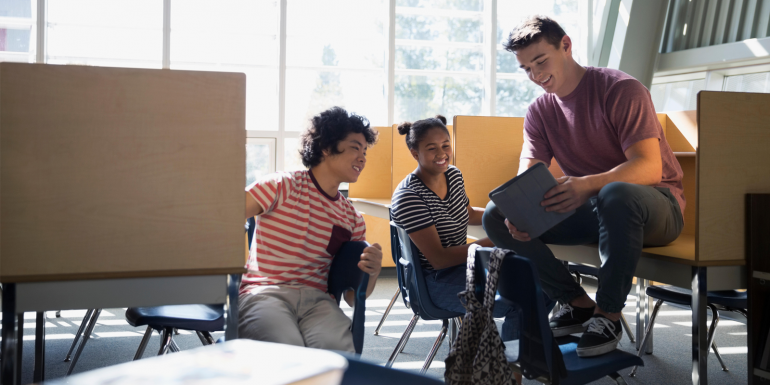
Teaching Titans vs. Punitive Professors
Partnering for solutions
Pearson Faculty Advisors have become educational first responders during this COVID-19 crisis; diving in to help professors use online tools effectively. We are teachers partnering together to share, learn, and pave the way in this brave new world of internet instruction.
Teaching online is nothing new to us. We’ve logged many years of working online with tools, instructional designs, and various learning management systems. But, watching every teacher in the United States move online in a matter of a few days, regardless of their comfort with distance learning, has been eye-opening. It’s challenged attitudes about online learning environments and the role of a college professor.
So many instructors are struggling with old ways and new challenges, trying to pound traditional classrooms to fit into bits and bytes. I’ve begun to recognize a clear dichotomy in instructional methods: restorative vs punitive. Looking to the experts for ideas, I discovered abundant pedagogical literature on this, making it far from being an original idea. The research is often directed at classroom management and changing student behaviors, but the principles apply to the consequences associated with our assessments, and whether they dish out “punishment” or increase learning.
Liberating learners vs. catching cheaters
There is much consternation amongst “instantaneous” online higher education teachers struggling to hold on to teaching methods that may not be functional for online classes. In brick and mortar classrooms, student mastery was often assessed through paper tests distributed with time limits, monitored by the roaming instructor to reduce cheating, and collected and graded by the teacher.
I’ve seen much hand wringing about how online environments simply cannot police students the way the classroom teacher could. And while the sudden shift to all things digital may revert to traditional classrooms, there may be lessons to be learned. These may be applicable for teaching anywhere and at any time. These atypical days are giving us time to reassess and find new ways to view classroom strategies or policies.
I’ve listened as teachers have listed the many ways they’ve discovered students can cheat by sharing information, invalidating their final scores. I’ve watched frustrated teachers try to create duplicate online classes that were once face-to-face, missing opportunities to increase student success. They are often missing the chance to use digital methods effectively, teaching the same principles in a different manner.
After hearing so much anxiety, I want to share some thoughts about how to be the rock star content expert, maintain your teaching rigor, and remain true to your unique personality with online learning. This may even transform that physical classroom in a return to the old normal.
What do I want from them?
There are so many disciplines and courses in higher education; it’s impossible to cover how every discipline should assess their student’s success. The following suggestions can be generalized and customized to meet the needs of specific courses and content.
“What should my students know by the end of my class?” should be the first question we ask when determining how to assess student progress. Much, or most, of class energy is spent acquiring information to pass the final assessments demonstrating mastery. Whether the course is psychology, speech, statistics, advertising, marketing, biology, or nursing, the time spent acquiring content is the formative stage of learning. Instructors are responsible for providing tools during these acquisition stages to help students “learn” the material in order to critically think through how to apply the new information in real world settings.
What do they need from me?
We are the facilitators of formative activities that help increase our students’ metacognition; helping them to know what they don’t know, and how to acquire the unknown information so they can apply it when required (tested). While formative activities will vary widely, their purpose remains the same.
These classroom techniques are meant for student learning, not assessing mastery by the instructor. I like to ask myself when selecting formative activities, “Is this something I can get out of the way of my students’ learning and let them be the captains of their own ship?”
Low stakes assessment of student progress includes activities that encourage students to reflect, collaborate, teach others, review, apply, or create. Incentivizing with points is vital for full participation. However, exams designed in anxiety producing high stakes testing environments seldom produce the long-term retention that incremental low stakes self-assessments do.
Consider formative activities such as group projects, encourage collaboration through discussion forums, offer opportunities for reflection through journaling, or ask opened ended questions on short, low-stakes quizzes.
Get out of the way and let them learn!
If you like auto-graded, time-saving multiple choice quizzes, leave them for student self-assessments. They can be great tools to let the student know what they don’t know yet, encouraging them to go back and review. But they tell us little about what students are retaining long-term and are rife with possibilities for easy “cheating.”
If quizzes are low stakes, there is little reason to spend the energy to cheat. I would ask, “If the student Googles the answer in a low stakes self-assessment, who cares?” It matters little whether they learned the information from reviewing the content I provided or from Google. If they spend the energy to look up the answer, they most likely will remember the question for some time to come. My passion for teaching is to produce life-long learners who seek information from every source available.
How do I know they got it?
There is a time for all instructors to summarize the total progress their students have made, or are making, during the term. Again, these “summative” assessments will take many forms depending on your specific course. I encourage instructors to think about limiting the number of these high-stakes assessments.
Keep in mind most of class time is spent in acquiring information or forming a new knowledge base. Students need enough time to get comfortable with the content before they really show you their critical thinking skills and applying their new information to unique and practical situations.
A personal example
Here’s a scenario that shows moving from formative to summative student assessment techniques:
- Weeks are spent training psychology students through low stakes assignments to write in correct APA style.
- The formative assessments are 250-word discussion forums in proper APA, encouraging students to review classmates’ work, compare their thoughts, and make comments on each other.
- There are usually 8-10 short, shared essays.
- By the end of the term, students demonstrate their mastery of both content and APA writing style through a summative research paper.
All assessments, both formative and summative, provided little chance or incentive to cheat as the essays and paper are submitted for originality checks. Students are ENCOURAGED to collaborate with each other, asking classmates’ input before submitting their final research paper.
Becoming a Titan
We all are challenged to keep teaching fresh and alive, to stay abreast of what is changing in our world, our students’ lives, our students’ learning, and our own wants and needs. I don’t want to create a classroom made for my needs. Rather, it should be one to help the maximum number of my students achieve their goals, persisting toward their degrees. As you think through how to provide formative steps toward knowledge acquisition that summarizes student progress, ask these questions:
In each segment/chapter/module/increment of learning, what should my students remember?
- How can I help them submit that information to their long-term memory? See this source for some ideas on retrieval practice.
How can my students demonstrate they have mastered the concepts I feel they need from my course?
- What kinds of assessments can I use that limit cheating and demonstrate real learning? See this resource for ideas about summative assessments.
Rock stars, every one
This may seem radical, but I want my students to share questions and answers, learn from each other, and become co-intelligent. I want to teach them that life is a group, not a proctored exam. Life is about solving large problems as a community, not being checked in isolation to see if we know everything about anything on one big exam. I want to be a learning facilitator. It’s all about my students’ learning, not about my need to perform. I may not be the rock star from your past. You may not remember my name. But if the tunes I taught you long ago hum in your head when you see a problem needing a solution, I’ve earned the title “Teacher”.



